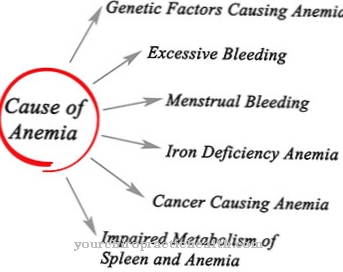At a Cystine stone it is a special type of urinary stone that is less common. Cystine stones are also known as cystine stones and are characterized by an approximately round shape. The contours of the cystine stone also partially adapt to the position in the renal pelvis. The surface of the cystine stone is smooth and reminiscent of wax. While the color of the cystine stones tends to be yellow, the stones are visually similar to frosted glass.
What is a cystine stone?

© Reing - stock.adobe.com
Cystine stones are relatively rare in the population. The stones arise as a result of an innate and genetically caused metabolic disease. However, only one to three percent of all urinary stones are cystine stones.
The stones are mainly caused by the patient suffering from urolithiasis. The underlying disease is cystinuria, which is inherited in an autosomal recessive way. Healthy people rarely collect cystine in their urine that exceeds the urine's potential to dissolve. People with cystinuria accumulate significantly increased levels of cystine in the urine, especially homozygous patients.
causes
The main factor in the development of cystine stones is the presence of hereditary cystinuria, which is passed on in an autosomal recessive manner and which is rare. People with cystinuria suffer from a metabolic disorder that causes an enormous amount of cystine to accumulate in the urine. The organism excretes more amino acids in the urine.
Healthy people secrete on average around 40 to 80 milligrams of cystine per liter of urine. People with cystinuria, on the other hand, often have concentrations of more than 1000 milligrams per liter of urine. Cystinuria refers not only to the substance cystine, but also to ornithine, arginine and lysine.
However, cystine is much more difficult to dissolve in urine than the other amino acids. The excessive cystine is therefore not completely soluble in the urine and crystallizes. As a result, the typical cystine stones develop in the sick.
Symptoms, ailments & signs
Cystine stones cause typical symptoms and ailments. Patients notice the first cystine stone mainly through sudden, severe pain. The sensation of pain arises from the fact that the cystine stone moves within the urinary tract. In particular, smaller stones or individual fragments slide from the kidney into the bladder and finally into the ureter.
In some cases, the cystine stone almost completely blocks the ureter. As a result, patients experience acute, intense pain in the flank area. The pain often spreads to the spine and groin. Most people see an ambulance in this condition because the pain is almost unbearable.
In addition, it is no longer possible to drain urine from the kidneys due to the constipation. The urine builds up, causing further pain. At the same time, the risk of urinary tract inflammation increases.
diagnosis
Patients with cystine stones usually see a doctor immediately as soon as the first stone is painful. The anamnesis may already reveal that the person is suffering from cystinuria. In some cases, however, the diagnosis of the rare hereditary disease is not made until the first stone causes acute pain. The doctor analyzes the patient's genetic disposition using a family history.
The clinical examination is based on different procedures. The doctor will use imaging methods and perform blood and urine analyzes. This shows the increased excretion of amino acids, which together with the acute symptoms of the cystine stones indicate the disease.
When should you go to the doctor?
If severe pain suddenly occurs when urinating, a doctor should be consulted. The doctor can use a clinical examination to determine whether a cystine stone is present and, if necessary, remove it directly. Occasionally, cystinuria can also be resolved by taking measures such as drinking heavily and climbing stairs. If the stone is left untreated, it may further clog the urinary tract.
In the further course, there is intense pain in the flank area, which can spread to the spine and groin. At this stage, self-treatment is no longer possible and an emergency doctor must be called immediately. A doctor should be consulted at the latest when symptoms of a urinary tract infection are noticed.
Since cystinuria is a hereditary disease, long-term medical clarification and treatment is imperative. Otherwise, new stones will form over and over again in the course of life, which impair well-being and gradually damage the urinary tract and kidneys.
Doctors & therapists in your area
Treatment & Therapy
A causal healing of the cystine stones is not possible. First of all, it is important that patients consume more water. In addition, surgical interventions are usually required to remove the cystine stones. The stones are removed in different ways.
In percutaneous nephrolitholapaxy, the doctor punctures the kidney with a hollow needle. An instrument is pushed through this needle that destroys and removes the cystine stones. A loop extraction is also possible, but this is rarely used these days. The method can only be used if the cystine stone is in the lower area of the ureter.
With the help of an inserted loop, the doctor pulls the cystine stone outwards. The risk of injuring the ureter with this procedure is relatively high, which is why the method is considered out of date. Alternatively, surgical removal of the cystine stones is possible. In most cases, the patient is given general anesthesia.
The surgeons then open the person's abdomen and remove the cystine stones from the kidneys or urinary tract. With all methods, it is important to prevent the formation of new stones after the removal of the cystine stones.
Outlook & forecast
Around 90 percent of cystine stones that are less than five millimeters in size are flushed out with the urine on their own. This can cause severe pain and, under certain circumstances, injuries to the urethra. If the cystine stones are not treated, serious complications such as injuries to the urethra and kidney can develop. The quality of life decreases sharply, and the formation of more stones also increases the original complaints.
If there is no treatment, the prognosis is rather negative, as larger cystine stones cannot be broken down by the body. In the case of surgical treatment, the prognosis is generally good. Consequential damage rarely occurs and removal with a puncture needle is symptom-free for the person concerned. Since stone formation is based on genetic causes, causal therapy is not possible.
Cystine stones can therefore reappear after treatment. Then another surgical treatment is necessary. If this is done early, the prognosis is usually good. Despite repeated interventions, cystine stones do not have any lasting effects on the health of the person affected. The recurring complaints can lead to emotional complaints in the long term and permanently impair well-being.
prevention
To prevent cystine stones, effective control of the underlying disease, i.e. cystinuria, is necessary. The patients consume a reduced proportion of certain amino acids. In addition, taking vitamin C is helpful in minimizing the concentration of cystine. In any case, it is important that the people drink enough water. Drinking water that contains a relatively high proportion of bicarbonate is recommended.
Aftercare
In most cases, the patient has no special follow-up measures available for a cystine stone. The person concerned is primarily dependent on a quick and above all on an early detection and diagnosis of this disease so that there are no further complications or complaints. An early diagnosis has a very positive effect on the further course of the disease, so that the person affected should contact a doctor as soon as the first symptoms and signs of the disease appear.
In most cases, the cystine stones can be passed through the urine. The affected person should drink a lot to increase the likelihood of elimination. In many cases, however, surgery is also necessary to remove the cystine stone. After such an operation, the person concerned should definitely rest and not strain his body.
Do not engage in physical or strenuous activities. Even after a successful procedure, regular examinations should be carried out by a doctor in order to detect any further damage at an early stage. Usually, a cystine stone does not reduce the life expectancy of those affected.





.jpg)



















.jpg)


